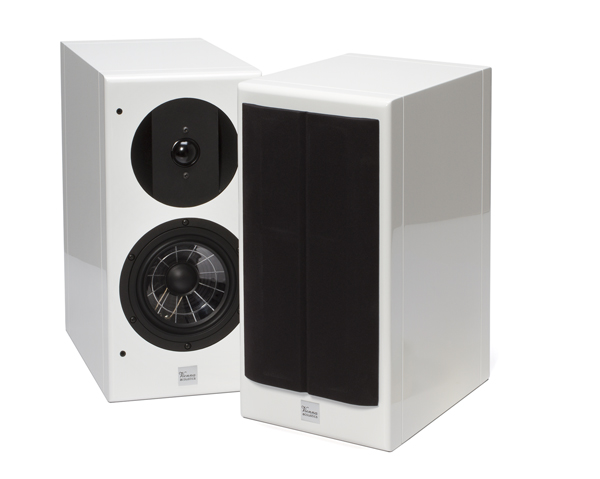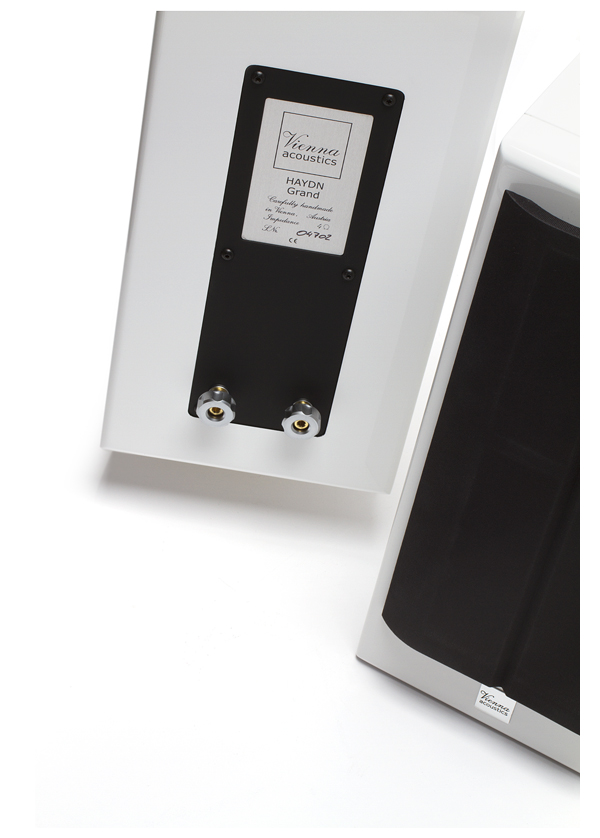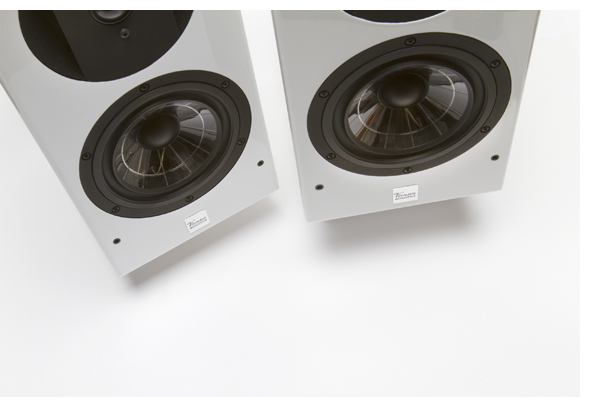 Vienna Acoustics takes pride in doing things somewhat differently than the rest of the pack. Most manufacturers refer to their SE models as “special editions,” yet the new Mozart is a “Symphony Edition.” A nice touch. Also, whereas many speakers utilize a ring radiator or metallic dome of some sort, Vienna chooses a 1.1-inch silk dome tweeter, produced to the company’s specs in the Scan-Speak factory.
Vienna Acoustics takes pride in doing things somewhat differently than the rest of the pack. Most manufacturers refer to their SE models as “special editions,” yet the new Mozart is a “Symphony Edition.” A nice touch. Also, whereas many speakers utilize a ring radiator or metallic dome of some sort, Vienna chooses a 1.1-inch silk dome tweeter, produced to the company’s specs in the Scan-Speak factory.
“We kept the front faceplate from a standard Scan-Speak tweeter to keep cost down,” says Kevin Wolff, Vienna Acoustics’ International Sales Director. “But inside, it’s all different. We pushed for a handful of design changes to make this tweeter really special.” And special it is. The tweeter is the same one used in the $6,500-per-pair Beethoven Concert Grand speakers and, like those pricier models, the $3,500 Mozart SEs redefine “sweet spot.”
A visit from Wolff underlines just how good these speakers are and how critical it is to fine-tune speaker placement. The Mozarts sound great right out of the box, but 20 minutes of careful fine-tuning takes them from great to sublime. Think, for a minute, how your car’s ride is affected with one tire underinflated. The crisp steering response you’re used to is diminished, but a quick trip to the air pump makes a substantial difference, making things right again. It’s the same with speaker placement. Once the Mozart’s are right, they disappear in the room like a great pair of mini monitors, but with a much more robust LF response.
Satisfied that things are performing properly, we audition a number of different tracks. At the end of our listening session, the MoFi LP of Marvin Gaye’s Let’s Get it On makes its way to the turntable and Wolff smiles. The Mozarts definitely have the juju, revealing the magic of the Lyra Atlas cartridge—quite impressive for any speaker, but even more so considering their reasonable price.
 Comfortable Playing Everything
Comfortable Playing Everything
The ultra-wide stereo effect of Lou Donaldson’s LD+3 immediately captivates, accentuating the improved sound of the Audio Wave remaster, as well as the timbral accuracy that the Mozart SEs bring to the presentation. While we can blather on about crossover slopes and the like, suffice it to say that everything works together brilliantly—in seconds you forget such tedious technical details and concentrate on the music. Gene Harris’ piano sounds wonderful and Donaldson’s sax commands the soundstage. The Mozart’s simply let the music shine through, leaving you to just enjoy rather than analyze.
Students of PRaT (Pace, Rhythm and Timing) will be instantly smitten with the Mozart SEs. Changing the pace from classic Blue Note jazz to the title track of Frank Zappa’s Jazz From Hell is equally fascinating. The Mozart SEs do not miss a lick of Zappa’s rapid time changes and dissonant textures. Donald Fagen’s new release, Sunken Condos, provides a calm middle ground. The highly textured and stylized studio recording illustrates how well the Mozart SEs effortlessly keep everything sorted.
Don Henley’s “Not Enough Love in the World,” from his album Building the Perfect Beast, is similarly rendered. This slightly compressed, over-processed and totally ’80s classic divulges new treasures. Henley’s voice has major depth, combined with layer upon layer of synthesizers—you can almost feel someone bending the pitch wheel on that Yamaha DX7. Leaving this ’80s genre for some heavier tunes proves an important point about the Mozarts: They give a riveting performance of less-than-primo recordings, an important consideration for those of us living in the real world.
U2’s Rattle and Hum has to be one of the most poorly recorded live albums in history. But, when cranking up “All Along the Watchtower” to what has to be the Mozarts’ breaking point (the meters on the ARC REF 250’s pushing close to the “caution” zone), the speakers handle it effortlessly, proving that these are not speakers limited to only a handful of audiophile-approved pressings. In the midst of this gigantic ball of midrange, you can distinctly pick out the Edge’s backup vocals over the distorted guitars and throttling bass line. The Mozarts are clearly just as comfortable playing it casual or formal.
The review wouldn’t be complete without playing a bit of the music for which these speakers are named—and Kathleen Battle performing “Motet; Exsultate, Jubilate, K.165” (from Kathleen Battle Sings Mozart) adequately fits the bill. Battle’s pure soprano gently fills the soundstage, going rapidly up and down the scale. Here, speakers lacking the Mozarts’ transient speed would blur horribly. Again, the Mozarts maintain the pace perfectly with complex fare, even at low volumes. The speakers realistically reproduce the violins while still giving more than enough weight to the orchestra.
Moving into a heavier and more-modern realm of musical selections, I was impressed with the level of bass output of the two 6.5-inch drivers. A long playlist of electronica and hip-hop tracks proves that these speakers are only limited by the accompanying amplifiers’ power reserve. Deadmau5’ “Right This Second” from the 4×4=12 album goes down very deep, forcing the Mozart SEs to move a serious amount of air, which they handle impeccably. Before bouncing back to Daft Punk, a quick interlude of Pink Floyd, Genesis and Mickey Hart confirms the speakers’ major bass output.
Labeled a 2.5-way system, the speakers are equipped with two woofers, which handle the deepest bass tones and combine the speed of smaller drivers but have the output of a single larger one. The lower driver gently rolls off as frequencies rise, offering the pinpoint imaging and low upper-bass coloration of a mini monitor.
Beautiful Inside and Out
Relying on gentle crossover slopes and wideband drivers, the Mozart SEs achieve a 90-dB sensitivity rating and are tremendously easy to drive. Crossover capacitors are matched to 1% tolerance and the inductors to .7%. You’d expect this kind of fanaticism in a $20,000 pair of speakers, but it’s unheard of in a $3,500 pair. “We only know how to build a speaker one way,” Wolff says with a smile, as way of explanation.
The cabinets of these beauties are equally sumptuous yet understated. The radius on the front baffle is hand-finished—the piano-black finish puts the paint job of an S-Class Mercedes to shame. The binding posts are unique to Vienna Acoustics, and they’re not those dreadful plastic-coated binding items that so many manufacturers have adopted. Even the front grille takes a different approach: The crease down the middle helps to channel tweeter energy, in “all but the most critical listening situations,” according to the company.
The drivers are VA’s own design, assembled at the Scan-Speak factory, and it’s worth noting that the woofers show an equal level of obsession on behalf of the manufacturer. The company utilizes its own X3P composite, which can vary in consistency to the intended application, so these are far from being off-the-shelf polypropylene cones. The transparent cone used for the Mozarts has become a VA design cue, blending visually into the design of the black speakers.
This extreme attention to detail reminds me of when Porsche introduced the first water-cooled 911. Comedian and freelance Porsche spokesperson Jerry Seinfeld commented on the “density of thought” that goes into the manufacturing of Porsche automobiles. Similarly, in sea of mass-produced speaker systems, the Mozart SEs exude quality, regardless of how far you dissect them.
Sure, the bigger VA speakers play louder and go deeper, but the sonic quality of these speakers is tremendous for $3,500. The Mozarts prove a phenomenal match for the new Primare I22 integrated DAC/amplifier that Wolff happens to have on hand. (A full review of that piece of gear is in the works.) At $2,499, the Primare is an awesome match to the Mozarts, as are the various other reasonably priced amplifiers we have at our disposal. Yet, when connected to a full complement of ARC reference components, the speakers deliver even greater performance, well beyond what you’d expect for $3,500 a pair.
You can get your own pair of Mozart SEs in Rosewood, Maple, Cherry or the Piano Black that our review sample arrived in. For an additional charge, a stunning Piano White is also available. The beautiful finishes of these speakers serve to remind that, in a world where a $20,000 price tag is more common than not, it’s refreshing to find a pair of $3,500 speakers that are built with the same level of care and attention to detail as those with a five-figure price tag.
The Vienna Acoustics Mozart SEs combine musical accuracy with dynamic ability in a compact and stylish package. They are not only worthy of one of our Exceptional Value Awards for 2012, they are one of the best speaker values this writer has encountered in a long time.
Vienna Acoustics Mozart SE loudspeakers
MSRP: $3,500/pair (cherry and piano black) $3,850 (rosewood and piano white)
Peripherals
| Analog Source | VPI Classic 1 Lyra Kleos |
| Preamplifier | ARC REF 5SE |
| Phonostage | ARC REF Phono 2SE |
| Power Amplifier | ARC REF 250 monoblocks Pass XA200.5 monoblocks Pass Aleph 3 Prima Luna Dialogue 6 monoblocks Carver VTM20, Primare I22 (integrated) |
| Digital Source | dCS Paganini Wadia 121 Sooloos Control 15 Aurender S10 Wadia 171 w/iPod Touch |
| Cable | Cardas Clear |


















